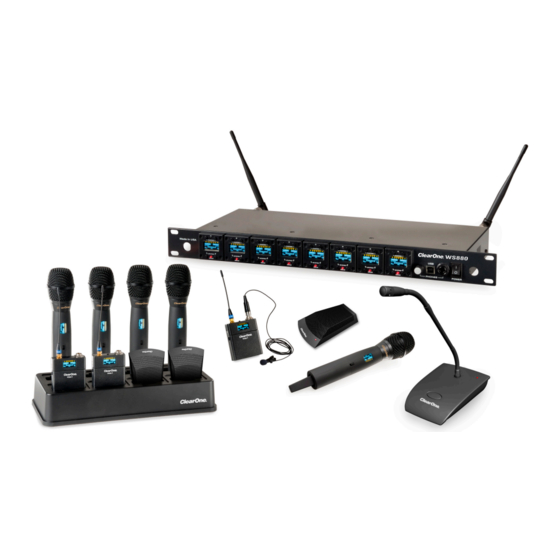ClearOne WS800 Manuale di applicazione - Pagina 7
Sfoglia online o scarica il pdf Manuale di applicazione per Sistema microfonico ClearOne WS800. ClearOne WS800 11. Wireless microphone system antenna application guide
Anche per ClearOne WS800: Manuale di avvio rapido (10 pagine), Manuale di avvio rapido (15 pagine), Manuale (5 pagine), Manuale di avvio rapido (13 pagine), Manuale di applicazione (12 pagine)

Appendix
(1) Intermodulation Distortion Interference (IMD)
Two or more transmitters operating in close proximity produce low-level, side-band frequencies called IMD.
These sideband frequencies can interfere with other microphones that normally operate on the same side-band
frequencies, but only when the IMD signal strength is comparable to the transmitter's signal strength. This can
happen when the interfering transmitters are in close proximity to the antennas while the interfered transmitter is
far away.
Case III - D above is a typical example. Microphones four
feet away from the antennas on stage left will have a signal
(and corresponding IMD) that is 64 times greater than the
signal from a transmitter that is 32 feet away on stage right
by the inverse-square law. In this case, the IMD signal will
cause dropouts and hits.
The science of IMD control is to arrange the antennas so
that all of the transmitters are about the same distance
away from an extension antenna. A good rule of thumb
is to divide the distance between the transmitters located
closest to an antenna and farthest from an antenna. The
result should be a number between 1 and 2. It may seem
counter-intuitive to move the antennas away from the
performance area to reduce dropouts, but Case III C will
have less IMD interference than Case III D.
In addition, ClearOne's digital wireless transmission
method uses numerical techniques that make them far
less prone to IMD interference than is possible with analog
systems. That is one reason ClearOne's arrays can be
much larger than is possible with analog systems.
(2) Diversity
Transmitter antennas radiate power in a toroid-shaped (donut) pattern. Very little energy radiates out the ends of
the transmitters. Separate the antennas sufficiently so at least one receives a strong signal.
(3) Dipole Antennas:
ClearOne systems are shipped with dipole (rabbit ear) antennas, but they are only recommended with small
systems and only when they are in the line of sight. They provide only a minimal diversity.
ClearOne recommends extension antennas whenever possible.
(4) Free Antenna Design:
ClearOne offers complete antenna hardware kits custom made for your project. The kits include extension
antennas, tested antenna cables with proper terminations, and antenna combiners if required. The goal of
extension antenna kits is to take all of the guesswork out of one of the most challenging and critical aspects of a
wireless microphone installation so your job is completed on time and within budget.
7
